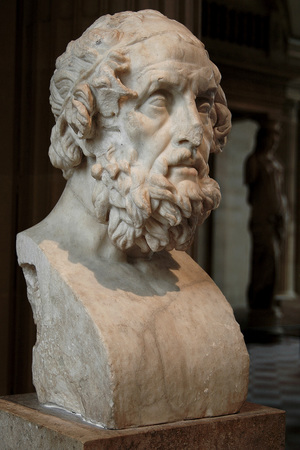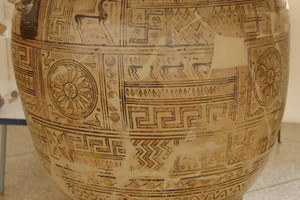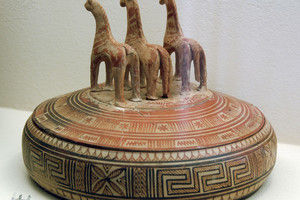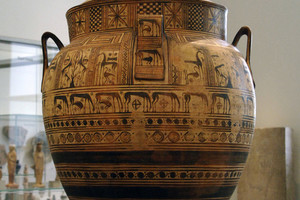Homeric Era
The period from the 11th to the 9th century BCE in ancient Greek history is known by two names: the Homeric Period and the Dark Ages. These names are not coincidental. It is called the Homeric Period because the epics of Homer, The Iliad and The Odyssey, are the only historical sources available for studying this period. The term "Dark Ages" is used to describe the economic and cultural decline that Greece experienced during this time.
The earliest known historical monuments of ancient Greek literature are Homer’s two epics, The Iliad and The Odyssey. The Greeks considered the author of these works a real historical figure, but scholars have questioned this, leading to the emergence of the so-called “Homeric Question” at the end of the 18th century. The main issue revolves around the origin of these epics. The founder of Homeric criticism, Abbot François d'Aubignac (1604-1676), wrote Dissertation on the Iliad (published in 1715), where he proposed that The Iliad was a compilation of songs by various aed singers and that Homer himself never existed. This perspective was further developed by the German philologist F.A. Wolf (1759-1824), who was the first to study Homer’s epics from a scientific point of view. Through his research, he raised the “Homeric Question,” which subsequently sparked much debate. In 1795, Wolf authored Prolegomena to Homer. In this work, Wolf questioned the traditional view of the unity of Homeric epics, offering three arguments in support of his thesis:
1. The presence of individual insertions and contradictions in the epics.
2. Ancient authors date the first recording of the epics to the time of Pisistratus (6th century BCE), which is several centuries later than the events described in the epics.
3. The development of Greek literacy, which the philologist dates to the 7th-6th centuries BCE.
Wolf considered it impossible for such lengthy epics to have been created in a pre-literate time. In his view, The Odyssey and The Iliad were collections of individual songs compiled during the time of Pisistratus. Wolf did not deny the cohesiveness and unity of the epics but believed that this unity lay in the material itself—in the myth—and could not belong to a single author. The philologist allowed for the possibility that most of the songs in the epics were the work of one author, whom he called Homer. After Wolf's work, a debate emerged among scholars, splitting philologists into two camps: analysts and unitarians.
Analysts
- G. Hermann's "Theory of the Original Core": According to this theory, The Odyssey and The Iliad did not emerge as compilations of independent works but rather as expansions of a "core" that contained the main elements of the plot. The foundation was two epics, Proto-Odyssey and Proto-Iliad. Later authors expanded and supplemented these epics, sometimes creating parallel versions of the same episode. As a result of these expansions, the epics grew until they were finally recorded in the 6th century BCE, in the form in which we know them today. The internal contradictions within the epics arose from the process of supplementation and expansion by various authors, but the presence of a core in each of the epics ensured the preservation of elements of unity.
- D. Grote's "Theory of the Core": This scholar saw The Iliad as a combination of two large poems: Achilleid and Iliad, with some songs being considered as separate works.
- K. Lachmann's "Theory of Small Songs": This philologist pointed out the discrepancies and contradictions between different parts of the poem, suggesting that they might have been written by different authors.
- A. Kirchhoff's "Theory of Compilation": According to this theory, the poems were composed not of separate songs but of four independent poems: a poem about Telemachus' journey, two poems about Odysseus' wanderings, and finally, a poem about Odysseus' return to his homeland.
Unitarians
The founder of this approach, G.W. Nitzsche, authored Studies on the History of Homer (1830-1837) and The Poetry of Legends Among the Greeks (1852). In his works, he argued that the compositional inconsistencies between different parts of the epics, which supposedly indicate collective authorship, are inherent in any literary work. Moreover, he asserted that such inconsistencies in Homer’s epics are so minor that they do not disrupt the artistic unity of the works. Additionally, Nitzsche claimed that literacy was not a necessary condition for the creation of such epics, and that writing appeared among the Greeks earlier than F.A. Wolf suggested.
The Current State of the "Homeric Question" and Possible Solutions
- The Iliad and The Odyssey contain several plot and compositional inconsistencies (e.g., two midday references, two lives, repeated murders).
- These epics exhibit layers from different periods, simultaneously depicting two eras. The narrative and plot pertain to the Achaean era, the time of the Trojan War and subsequent battles. However, the economic, cultural, and social realities are those of the Dark Ages. Despite being purely artistic works, their historical value is immense.
- The creation of these epics is dated to the 9th-8th centuries BCE, with The Iliad being written earlier than The Odyssey.
- The formation of the epics occurred in Asia Minor, in the Ionian-Aeolian region, within an aristocratic environment that preserved the traditions and culture of the Mycenaean era.
- The Iliad and The Odyssey are connected into a single artistic whole.
The divergence between the primary artistic vision and the material compiled in the Homeric epics can be explained in different ways. On one hand, this could have arisen because the smaller Proto-Iliad and Proto-Odyssey, which already contained the basic concept, were later subjected to various revisions and expansions (the "core theory"). On the other hand, the unitarian hypothesis suggests that the artistic design of the epics in their current form represents the final stage in their development, meaning that each epic has its own "creator" who reworked the ancient material, shaping it to fit their vision, but was unable to completely erase the traces of the diverse sources used. There is also a theory that The Iliad and The Odyssey, even as large epics, were supplemented with new episodes.
In conclusion, the specific history of the composition of the Homeric epics remains a matter of debate.
Vessels in the geometric style, such as the pyxis from the 11th-9th centuries BCE (Archaeological Museum of Kerameikos, Athens), and the krater from 750-740 BCE (found in Kourion, Cyprus, now in the Metropolitan Museum of Art, New York), provide essential archaeological evidence that complements the Homeric epics. The bulk of the archaeological material comes from necropolises, with the largest discovered in Athens, Euboea, Salamis Island, and around Argos.
The economy of this period was primitive, with the population mainly engaged in agriculture and animal husbandry. The Dorian conquest disrupted trade connections with the Near East and other Mediterranean states. Many crafts were forgotten, and writing disappeared (archaeologists have found no inscriptions in Greece dating to the period between the 11th and 9th centuries BCE). Barter was the predominant form of exchange, as monetary systems were absent. The population lived in small rural settlements or "proto-cities" like Smyrna. Unlike the Mycenaean period, no palaces or stone fortresses were built; structures were mostly made of unbaked bricks or wood, and none have survived. Household items were simple and modest. Grave goods usually consisted of a few clay pots, arrowheads, and spearheads, or bronze or iron swords in men’s graves, with cheap jewelry found in women’s graves. Luxuries and foreign items, common in Mycenaean tombs, are absent. However, it was during the Homeric era that the Greeks began to work with iron. The Achaeans lived under the Bronze Age until the arrival of the Dorians, who brought iron, laying the economic foundation for the future advanced Greek civilization. The widespread adoption of this new metal marked a kind of technological revolution. Iron is more abundant in nature than the components of bronze—copper and tin—making it cheaper and more accessible. The creation of new iron tools allowed for an increase in craft and agricultural production. Furthermore, the development of pottery and blacksmithing also benefited from iron, leading to the emergence of ceramic products in the geometric style. The widespread use of iron tools laid the groundwork for small farming households to become the basis of the future Greek economy.
The social structure was based on clan and tribal divisions. The phylae and phratries were the basic units of tribal society. Each phratry consisted of several clans, and several phratries made up a phyle. Clan conflicts and blood feuds were common. Over time, the significance of clans and tribes diminished, and an increasing number of people began to live in small families, running their own households. Eventually, blood feuds also disappeared, leading to social inequality:
1. Nobility: According to Homer, the basileis were the most powerful and influential members of the aristocracy. Later ancient authors referred to basileis as kings.
2. Free Population: These included peasant community members and craftsmen who fulfilled obligations to the nobility and lived off their own land.
3. Thetes: Impoverished community members.
4. Slaves: The question of slavery during this period is debated, as it is unclear whether it was a classical form of slavery or a patriarchal one.
The basileus (Greek: βᾰσῐλεύς – king) held many powers: military leader, judge, community ruler, and speaker at the public assembly. Over time, this authority became hereditary. The council of nobility served as an advisory body to the basileis. The public assembly was another advisory body that gathered to discuss important community issues, attended only by men.
The political system of the Homeric period is another subject of debate. Some scholars refer to this system as a military democracy, while others argue that the public assembly had no regular basis or authority to enforce its decisions. In any case, the basileis played a significant role in decision-making.
In conclusion, the 11th-9th centuries BCE were a time of decline and cultural stagnation, but this period also saw the struggle between the old and the new, changes in customs and the clan system, and the updating of technical bases, such as the spread and integration of iron into production. These developments set the stage for the Greek poleis to embark on a new path of historical development, leading to unprecedented cultural and social progress in Greece a few centuries later.
Related topics
Ancient Greece, Archaic Greece
Literature
1. Andreev Yu. V. The Early Greek Polis (Homeric period). 2nd ed., additional edition — St. Petersburg: Humanitarian Academy, 2003, 447 p.
2. Andreev Yu. V. Gomerovskoe obshchestvo [Homeric society]. The main trends of socio-economic and political development of Greece, XI—VIII centuries BC — SPb.: Nestor-Istoriya., 2004. — 496 p.
3. Homer. The Iliad. Odyssey, Moscow: Prosveshchenie Publ., 1987, 400 p.
4. History of Ancient Greece/ Edited by V. I. Kuzishchin.Moscow: Vyssh. shk., 2003, 399 p. (in Russian)
5. Radzig S. I. Istoriya drevnegrecheskoy literatury [History of Ancient Greek Literature], Moscow: Higher School, 1982, 487 p.
6. Sergeev V. S. Istoriya Drevnoi Greksii [History of Ancient Greece] St. Petersburg: Poligon Publ., 2002, 801 p .
7. Tronsky I. M. Istoriya antichnoi literatury [History of ancient literature], Moscow: Vysshaya shk., 1983, 464 p.






